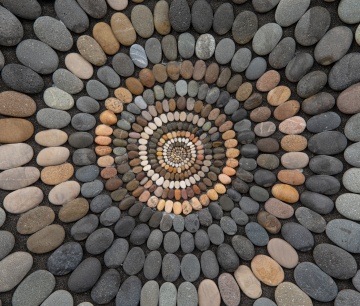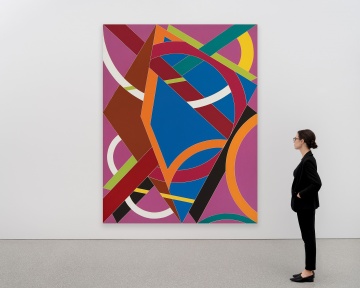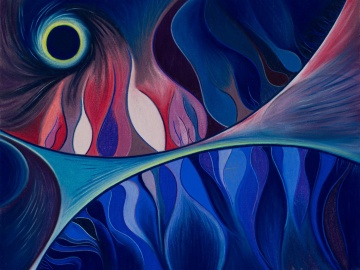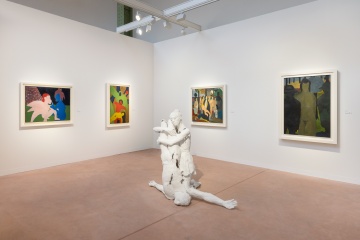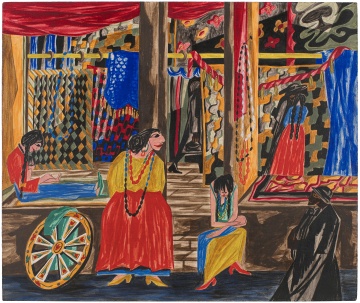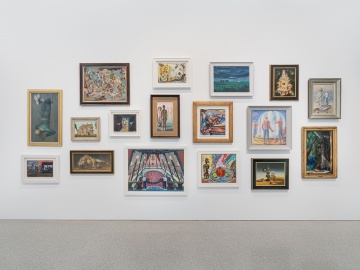Michael Rosenfeld Gallery
100 11th Avenue
New York, NY 10011
212 247 0082
New York, NY 10011
212 247 0082
Michael Rosenfeld Gallery champions artists who have made invaluable contributions to the canons of twentieth and twenty-first century American art.
Artists Represented:
Benny Andrews
Hannelore Baron
Mary Bauermeister
John Biggers
Federico Castellon
Harold Cousins
Beauford Delaney
Morris Graves
Nancy Grossman
Norman Lewis
Seymour Lipton
Boris Margo
Theodore Roszak
Bob Thompson
Charmion von Wiegand
William T. Williams
Works Available By:
Charles Alston
Leo Amino
Robert Arneson
William Artis
Ruth Asawa
John Atherton
George C. Ault
Milton Avery
Edward Mitchell Bannister
Richmond Barthé
William Baziotes
Romare Bearden
Eugene Berman
Harry Bertoia
Charles Biederman
Isabel Bishop
Emil Bisttram
Oscar Bluemner
Norman Bluhm
Ilya Bolotowsky
Lee Bontecou
James Brooks
Charles Burchfield
Paul Cadmus
Elizabeth Catlett
Barbara Chase-Riboud
Robert Colescott
Joseph Cornell
Eldzier Cortor
Manierre Dawson
Jay DeFeo
Dorothy Dehner
Joseph Delaney
Burgoyne Diller
Aaron Douglas
Arthur Dove
Werner Drewes
Robert S. Duncanson
William Edmondson
Louis Eilshemius
Jimmy Ernst
Minnie Evans
Philip Evergood
Claire Falkenstein
Herbert Ferber
John Ferren
John Flannagan
Suzy Frelinghuysen
Jared French
Albert E. Gallatin
Ed Garman
Sam Gilliam
Fritz Glarner
Michael Goldberg
Arshile Gorky
Adolph Gottlieb
John Graham
Robert Gwathmey
David Hare
Lawren Harris
Marsden Hartley
Palmer Hayden
Sheila Hicks
Hans Hofmann
Charles Howard
Alfred J. Jensen
Jess
Malvin Gray Johnson
William H. Johnson
Joshua Johnson
Lester Johnson
Sargent Johnson
Raymond Jonson
Gerome Kamrowski
Frederick Kann
Leon Kelly
Paul Kelpe
Willem de Kooning
Lee Krasner
Walt Kuhn
Yayoi Kusama
Gaston Lachaise
Ibram Lassaw
Jacob Lawrence
Blanche Lazzell
Hughie Lee-Smith
Alfred Leslie
Lee Lozano
Martha Madigan
Conrad Marca-Relli
John Marin
Reginald Marsh
Jan Matulka
Alfred Maurer
Joan Mitchell
Robert Motherwell
Archibald J. Motley, Jr.
Jan Muller
Walter Tandy Murch
Elie Nadelman
Alice Neel
Louise Nevelson
Irving Norman
Alfonso Ossorio
Agnes Pelton
Irene Rice Pereira
Marion Perkins
Horace Pippin
Charles Ethan Porter
Fairfield Porter
Richard Pousette-Dart
Milton Resnick
Mark Rothko
Anne Ryan
Betye Saar
Kay Sage
Augusta Savage
Rolph Scarlett
William Edouard Scott
Charles Seliger
Ben Shahn
Charles G. Shaw
Albert Alexander Smith
Raphael Soyer
Theodoros Stamos
Richard Stankiewicz
Joseph Stella
Louis Stone
Toshiko Takaezu
Henry Ossawa Tanner
Dorothea Tanning
Lenore Tawney
Pavel Tchelitchew
Alma Thomas
Mark Tobey
George Tooker
Bill Traylor
Jack Tworkov
Laurence Vail
James VanDerZee
Robert Vickrey
Peter Voulkos
Laura Wheeler Waring
Max Weber
Charles White
John Wilde
Ellis Wilson
Beatrice Wood
Hale Woodruff
Jean Xceron
Claire Zeisler
William Zorach
Art Basel Miami Beach 2025
December 5, 2025 - December 7, 2025
Michael Rosenfeld Gallery is proud to announce its return to Art Basel Miami Beach for its nineteenth year. The selection of masterworks on view highlights the depth and breadth of the art and artists championed by the gallery, encompassing abstract expressionism, surrealism, figurative expressionism, as well as geometric and spiritual abstraction.
Mary Bauermeister | Kabinett, Art Basel Miami Beach
December 5, 2025 - December 7, 2025
For the Kabinett sector at Art Basel Miami Beach 2025, Michael Rosenfeld Gallery is excited to present a solo exhibition of rarely-before-seen works on paper by Mary Bauermeister (1934–2023).
Bob Thompson, Karon Davis
Bob Thompson & Karon Davis at Art Basel Paris
October 24, 2025 - October 26, 2025

 Back to all Member Galleries
Back to all Member Galleries

